|
September 9th, 2004
Just a note, Sinopia's Indian yellow is labeled PG10 F = Green Gold, it could be called Indian Yellow G/s but it's not. Williamsburg Magenta does not match the perfect color of Liquitex's Acra Violet, it's name was changed to Liquitex Acra Magenta PR122. Williamsburg Magenta has more like a Alizarin Crimson base with PR202 added, it's not a clean color, not the PR122 that Liquitex uses. I thought the ASTM was to eliminate confusion. This is a quote from the Artist's Handbook of Materials and Techniques, 1940.
Well we need a new system, this 1940 Color Index system doesn't work anymore. One reason is because it is based on Chevreul's red, yellow and blue colorwheel instead of the correct yellow, magenta, cyan colorwheel. Another reason is it does not show the position relationship between any two colors. PV19 is quinacridone, the chemical can be a transparent color from red to magenta to violet.
Today I notice a lot of distributers using only the PV19 to cover the whole magenta range. Don't be mislead!
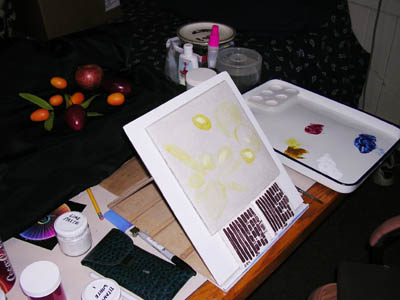 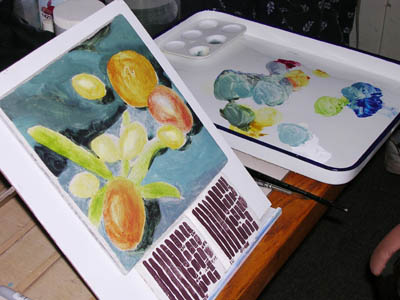 7:30, I let it set for ten minutes then wet the whole fresco with lime water. I paint with the panel in an upright angle, wet it with spray in the horizontal position.
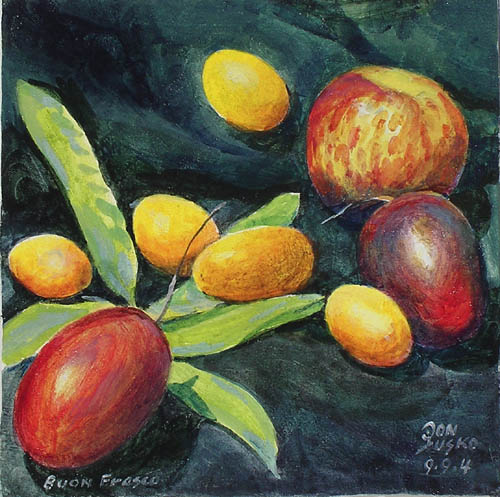 09-11-04, The Williamsburg Magenta PR122 is turning brown in the wet lime jar test and fresco already, this is not a PR122 trait. It is an alizarin crimson trait though.
Start 6:00 Am, brushed on lime water until it soaked in all over the fresco. This removed any building crust that will impede color absorption. The next day's crust can be removed with a light wet sponging. 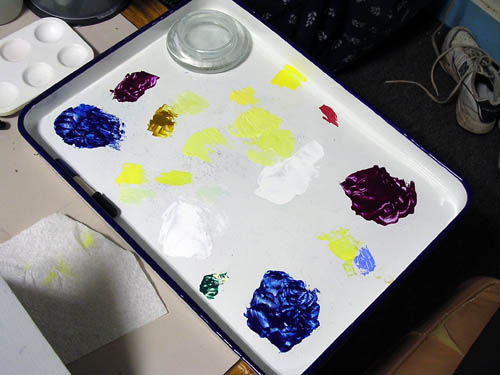 Sinopia Priderit yellow PY157 RCW#36.0 is a yellow green that is made similar to cad yellow light and viridian mixed. This makes a warmer yellow-green than if you mix it with Thalo blue.
Daniel Smith's Magenta is PR212, is a transparent violet side magenta. It does not make good reds or oranges. That would be RCW#14.6 Transparent on the Real Color Wheel.
Zecchi Thioindigoid red PR88. RCW#7.0 Opaque is better than the same colored pigment cadmium red. Both colors have similar opaque qualities. Thioindigoid red stays brighter on the fresco and has better painting qualities. Cobalt blue light PB28. RCW#22.00 Opaque is the only cobalt blue I found permanent. The rest turned dark gray. Cadmium orange PO20. RCW#4.0 Opaque Cadmium orange. Sinopia phthalocyanine 15.3. RCW#25.6 Transparent is a clean cyan. Viridian green PG18. RCW#31.0 is easy to use and works like phthalocyanine green, in fresco only.
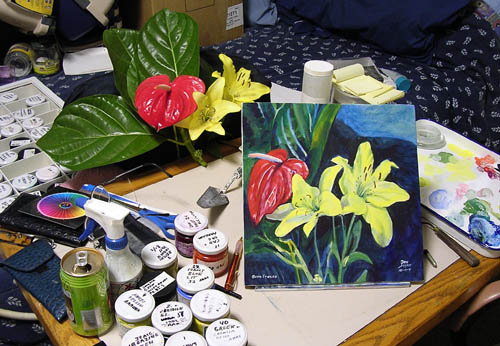 8:50, 90% finished, sprayed it down completely.
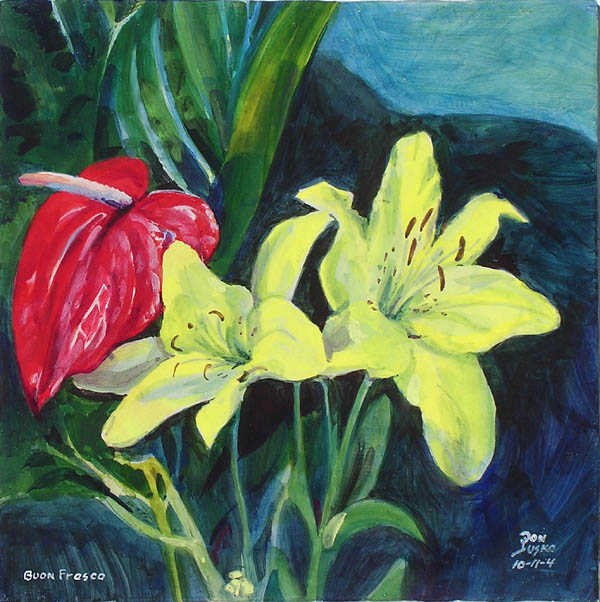 10:15, Sprayed again.
12"x12" Boun Fresco I had to stop adding color because of the angle of the sun was coming in the window and changing all my colors. I wet it down, covered it with plastic and a wet rag. I have it covered 90% with color. My colors are Red PR88, Quinacridone magenta PR212, Irgazine green PY129, Indian yellow PY153, cobalt blue light, cobalt turquoise, viridian PG16, cyan PB15.3, indanthrone blue plus titanium white. I drew the in drawing with Indian yellow for the urn and indanthrone blue for everything else. The brass shadows are irgazine green and mars red. The red bottle darks have cyan as the complement.
 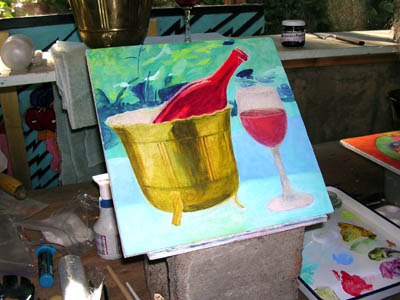
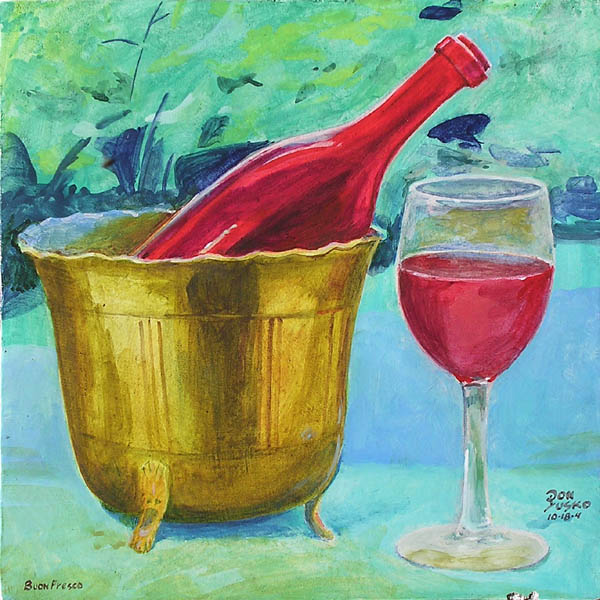
Cadmium red would not have given me this brilliance in the Red Bottle. Thioindigoid red PR88 (same as Grumbacher Red) is the better choice in all media.
TIP: Add to a painting with ammonia, remove paint with water.
9-25-4. The glass is drawn in, the wine bottle got it's first coat of cera colla. In the morning I'll soak it and start chipping away at the glass area of the intonaco. The applied cera colla media looks milky tonight.
I shot the picture, soaked the panel and started removing the intonaco for the glass. Lime hardens from the top and this one is already getting a hard crust that has a slight sheen. Under the crust the mortar is easy to remove. This picture is the buon fresco.
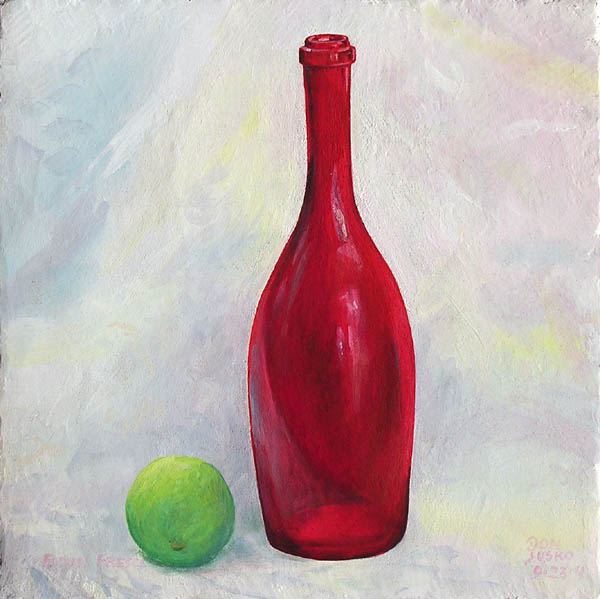 The next fresco page #38 shows the new giornate added and the Cera Colla work done to this fresco.
See Gail Resta painting a buon fresco of Buddha in Piero's Kaupo studio, a few yards from the Villa Tamarianda acrylic painting.
|
